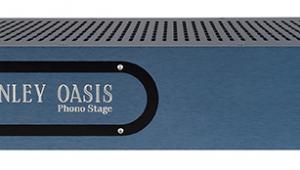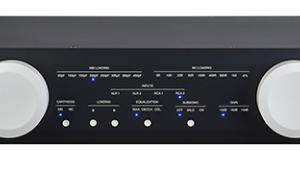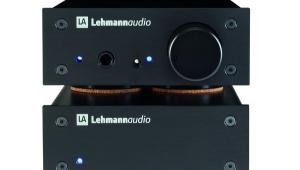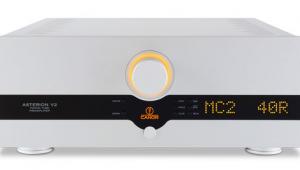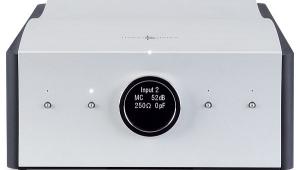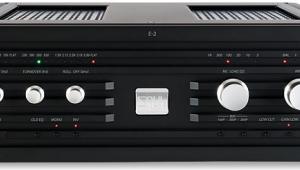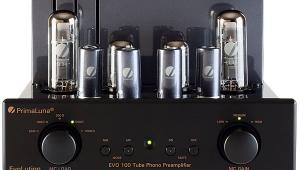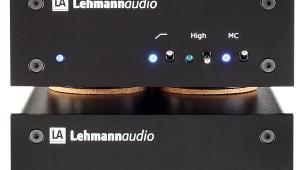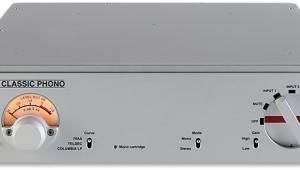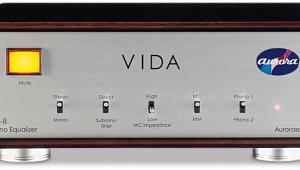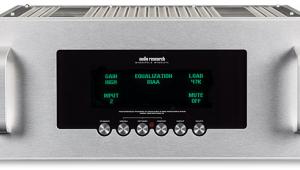Avid Pulsare Phono (£3000)
When someone as determined and perfectionist as Conrad Mas of Avid decides to enter a new product area, the result is likely to be something special. With the Pulsare Phono, the aim was to produce a phono stage that could do the same things for music that an Avid turntable did. It had to have ‘that certain something that makes the music sound and feel real.’ Even a first glance tells you that this an overkill design in specification, construction and features. Avid, which now has design and engineering facilities almost unrivalled in specialist audio, has already delved into electronics with its advanced power supplies, and from there a phono stage was a logical next step.
POWER MOVES
Many designers have echoed the truism that in reality an amplifier doesn’t actually take small signals in at the input and make them bigger at its output. In reality, the amplifier produces that larger output by modulating what’s coming from the power supply in accordance with the input signal.
You can apply a rather similar argument to turntables, where the finest motor is only really as good as the power it receives. Avid has always believed in using a very high-torque motor to really control the platter, and then using a high-grade power supply to control the motor. Even its standard Acutus PSU is in reality a big two-channel amplifier, providing power at a fixed frequency separately and with the appropriate phase angle to the two ‘phases’ of the synchronous motor.
But in 2006, Avid went further than this with the Acutus Reference Power Supply. Here the already beefy 80VA mains transformer at the input was replaced by a huge custom-built transformer rated at 1000VA. This might seem like real over-engineering, but it gave a sonic benefit.
With this background, it’s no surprise that the new Pulsare Phono is provided with a massive separate power supply. Rated at 300VA, this comes in the same elegant casework as the Acutus Reference unit. But if the power supply box looks imposing, Avid has outdone itself with the Pulsare Phono itself.
There can’t be many phono stages with such complete front-panel facilities, and there probably aren’t any where the controls are executed with such style. The Pulsare’s solid fascia, its discreetly business-like silk screened legends and above all its four classic, top-grade rotary control knobs have all the solid quality and seriousness of a 1950s communications receiver. And rather like one of those wonderful all-band radios, the Pulsare is intended to cope with any input you throw at it. So long as it comes from a phono cartridge, of course.
Starting from the left, the first control is an input selector, provided because the Pulsare is designed with balanced circuitry throughout and offers balanced inputs on XLR sockets as well as the standard phono inputs. Few tonearms are equipped with true balanced signal wiring and XLR connectors, although it’s generally accepted that there can be major sonic benefits, so this could be a worthwhile upgrade for many systems.
The other switch positions select the phono input sockets, giving a ‘balanced’ option as well. Which of these you choose depends on the wiring of your turntable and arm. If the turntable grounds one of cartridge signal wires, there is likely to be more mains hum with the switch set to balanced. There is a ground lift switch on the rear panel, and this may be useful if the system displays an obstinate hum problem.
Next along on the front comes the gain control, to be set to best match the cartridge being used. Most phono stages provide gain switching for MM and MC cartridges, the gain settings usually being 40 and 60dB respectively. Avid goes one or two better than this, with gain settings of 40, 50, 60 and 70dB provided by the next rotary control.
These last three are named for the gain rather than the cartidge output level and so are labelled MC (low), MC (med) and MC (high), intended to cater for MCs with nominal outputs of around 600µV-3mV, 250-750µV and 100-300µV respectively. This means you should easily be able to find the right gain setting for almost any cartridge, used with any sensible main amplifier.
Still more comprehensive is Avid’s nine-position load impedance selector. As well as the standard moving-magnet load setting of 47kohms, this give options of 10, 30, 100, 500, 1k, 5k and 10kohms. Again, trial and error should give you the ideal setting for just about any moving-coil cartridge.
Lastly, the right-most rotary control allows you to add capacitance loading for MM cartridges, typically used to tame the treble output. Once more there is maximum choice: as well as the usual 100, 200 and 500pF, you get the more extreme options of 1.5, 10 and 20nF.
OUT OF THE BLUE
Armed with a small collection of cartridges and a large collection of records, and with the excellent Lehmann Black Cube Decade phono stage as a reference, I started listening.
I put on Joni Mitchell’s Blue [Reprise K 44128] and, as so many times before, wondered how this 39-year-old piece of vinyl managed to seem so fresh and communicative. With the Lehmann, the performance was delightfully well balanced and informative, and in isolation I think there would have seemed little or nothing to criticise. Yet there was more.
Changing to the Avid Pulsare, on the opening track ‘All I Want’, there was suddenly a fuller awareness of the guitars and voice and even of the discreet percussion as individual sonic entities. It was as if you could now hear round them, so to speak, just as you would if a real instrument was playing in front of you. Also, you were made aware of the sheer craft and sophistication of the guitar accompaniment. You weren’t just hearing chord changes, you could hear the way the instrument provided bass patterns, harmony and a counter melody too. And the Avid seemed capable of uncovering yet further nuances even in such familiar material.
Next up was the great Harry James band direct cut, The King James Version [Sheffield Lab LAB-3]. From the opening of ‘Corner Pocket’, the double bass sounded plump and firm, rich yet still with a springy quality, the ride cymbal realistically insistent. In the leader’s trumpet solo here, you could just feel the way he was shaping every note so expressively, and the same went for his beautifully relaxed playing on ‘Lara’s Theme’ and ‘More Splutie Please’. Here the brass really did sound brassy, yet without the sense of strain so often heard on big-band records.
On ‘Cherokee’, Le DeMerle’s drums sounded great, and at the same time you could feel that the rest of the band was really steaming with him.
Moving on to Eric Clapton and ‘Motherless Children’ from 461 Ocean Boulevard [RSO 2479 118], once again I felt that the bass was outstanding, with Carl Radle’s deceptively simple playing heard clearly as the indispensable foundation of the track, playing off a rock-solid drum sound. While the bottleneck sound zoomed over them, the rhythm guitars snarled and snapped emphatically, in a background that never became messy or incoherent.
Yet the Avid was even more impressive on the next track, the contrasting ‘Give Me Strength’, where the atmospheric organ, guitar and rhythm section seemed to fill a huge space with a sound that could only be called sumptuous.
With the Lehmann phono stage, playing ‘Easy Money’ from Rickie Lee Jones [Warner Bros K56628], the singer had sounded sweet and slightly recessed, with the string bass full and in some danger of becoming overpowering. Moving to the Avid, there seemed to be a subtly different balance of forces, Rickie Lee sounded a little more forceful and forward, her voice distinctly set in its own acoustic space with her breathing clearly heard, while the bass sounded powerful and actually still quite dominant but somehow firmer as if under tighter control.
Turning to the classical old faithful, English String Music with the Sinfonia of London under Barbirolli [EMI ASD 521], the Avid seemed able to reveal the scale and depth of the venue while giving a feeling of clear precision in the sounds of the strings themselves. In staccato passages, it conveyed the sharp attack of the bowing in a very lifelike way and, in the sweeping legato themes, there was a winning combination of clarity and ambience. The recording could sound atmospheric, but never hazy, as the Avid just seemed to recover detail and ambient clues quite effortlessly.
NOW HEAR THIS...
Next I changed cartridges, installing the Koetsu Black in place of the Ortofon. With the Koetsu, the Harry James band’s bass player made a slightly fluffier, softer sound, but still bounced the band along well. And the drums sounded coherent, tight and punchy too. Subjectively, I felt that the Avid was really exceptionally transparent to the virtues of the Koetsu, which as so often happens, gave a cohesive and open-heartedly appealing result overall, even if you could nitpick over certain aspects.
Moving again to Barbirolli’s English String Music, and listening to the Elgar Introduction And Allegro, the Koetsu gave a warm, resiny, deep-staged view of the performance, as if the venue was now panelled in dark wood. It lacked the Ortofon’s hear-through impression of detail and the bass lacked the clarity and elasticity of the Ortofon, which had revealed Elgar’s great double bass lines so clearly. Again, I felt that the Avid phono stage was very, very capably revealing the different character of the cartridges.
VERDICT
Scoring on build quality and facilities as well as excellent sonic performance, this is clearly one product that will outlast many other changes in a system. You may not intend to go balanced just yet, you may not need all those cartridge matching options this minute, but it is great to have such flexibility now and for the future, with no need for fiddly DIP switches or jumpers. This is an impressive product indeed.
Sound Quality: 89%
Originally published in the August 2010 issue


